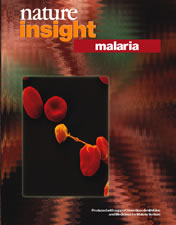Malaria
 |
| Cover
illustration |
Vol.
415, No. 6872 (7 February 2002).
|![]() PDF
PDF![]() (106
(106![]() K)
K)![]() |
|
In any given year, nearly ten per cent of the global population will suffer from malaria — 500 million clinical cases — and more than 1 million will die as a result; a death from malaria every 30 seconds. In Africa, the disease kills one child in twenty before five years of age.
And things are getting worse, as malaria is undergoing a resurgence. The main contributing factors are the emergence of drug-resistant strains of the parasite, the appearance of mosquitoes (which transmit the parasite) that are resistant to insecticides, environmental changes and increased population.
After decades of relative lack of attention, growing international awareness and funding has led to new efforts towards controlling the disease. A wide-ranging coalition of interests is being marshalled to combat malaria, including: global healthcare planning, specifically the World Health Organization's 'Roll Back Malaria' campaign, which aims to halve the burden of disease by 2010; pharmaceutical industry support; research coordination, with the main funding agencies coming together in the Multilateral Initiative on Malaria; and philanthropy, most notably the Malaria Vaccine Initiative supported by the Bill and Melinda Gates Foundation.
While this points to an appropriate level of concern and urgency, the most critical challenge is to the researchers. Can they supply the knowledge and tools needed to combat this devastating disease? This Insight will go a long way to answering that question, describing latest research developments, likely future progress and the practical impact that the new knowledge will have.
Ursula Weiss Senior Editor
All of the articles in this Insight are free to registered users of Nature's web site. Registration is a simple process which should take only a few minutes to complete. You can sign up here.
Malaria
in 2002 BRIAN GREENWOOD AND THEONEST MUTABINGWA
| 670 | ||
| The
pathogenic basis of malaria LOUIS H. MILLER, DROR I. BARUCH, KEVIN MARSH & OGOBARA K. DOUMBO
| 673 | ||
| The
economic and social burden of malaria JEFFREY SACHS AND PIA MALANEY
| 680 | ||
| Medical
need, scientific opportunity and the drive for antimalarial drugs ROBERT G. RIDLEY
| 686 | ||
| Progress
and challenges for malaria vaccines THOMAS L. RICHIE AND ALLAN SAUL
| 694 | ||
| Plasmodium,
human and Anopheles genomics and malaria STEPHEN L. HOFFMAN, G. MANI SUBRAMANIAN, FRANK H. COLLINS & J. CRAIG VENTER
| 702 | ||
| Satellite
imagery in the study and forecast of malaria DAVID J. ROGERS, SARAH E. RANDOLPH, ROBERT W. SNOW & SIMON I. HAY
| 710 | ||
The
Medicines for Malaria Venture
| 715 | ||
GlaxoSmithKline
and malaria
| 716 | ||